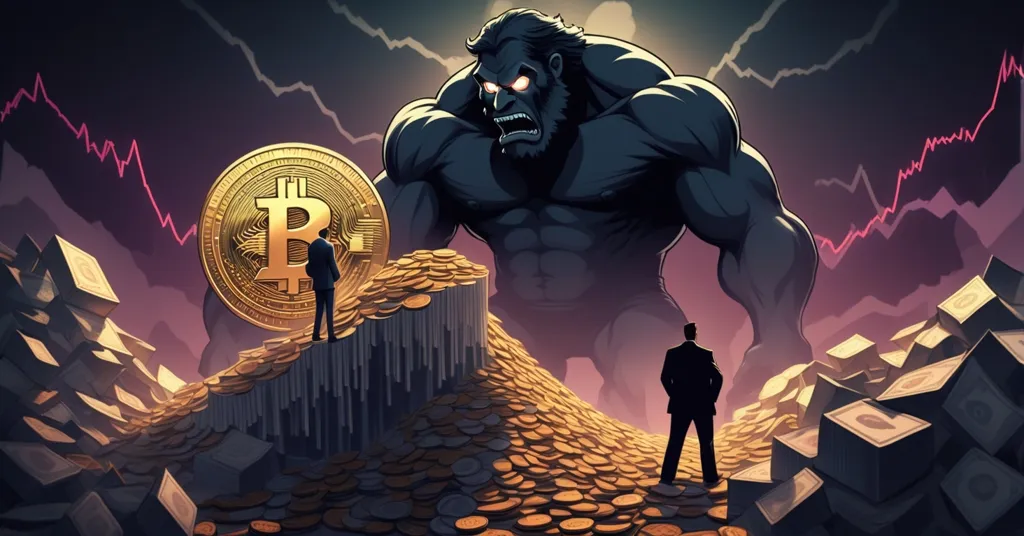XRP Fears Mount as Chris Larsen Transfers 50M Tokens, Price Drops 13%

XRP Panic: Chris Larsen’s 50M Token Transfer Fuels Sell-Off Fears
Ripple co-founder Chris Larsen has rattled the XRP community with a transfer of 50 million XRP to exchanges, igniting widespread fears of a potential sell-off. With Larsen still holding a staggering 2.58 billion XRP—valued at approximately $8.83 billion—the move has sparked intense speculation about whether this is merely a prelude to a larger dump, especially as XRP’s price already took a 13% hit, dropping to $3.18 amid market chaos.
- Triggering Alarm: Larsen moves 50 million XRP to exchanges, hinting at possible profit-taking.
- Giant Holdings: Retains 2.58 billion XRP, a looming $8.83 billion risk to market stability.
- Price Hit: XRP falls 13% to $3.18, caught in broader crypto volatility.
Larsen’s Move: Sell-Off or Strategic Play?
The crypto space thrives on speculation, and Larsen’s recent transfer of 50 million XRP—worth about $175 million at the time—has set tongues wagging. On-chain data tracked by blockchain sleuth ZachXBT shows this movement occurred between mid-July and recent days, with tokens landing on exchanges, the usual pitstop for liquidation. While this is a tiny fraction of his total 2.58 billion XRP stash, the sheer size of his holdings—roughly 4.6% of XRP’s market cap—makes even small moves feel like tremors before an earthquake. CryptoQuant analyst J.A. Maartunn issued a stark warning to XRP holders, cutting straight to the chase.
“Don’t get dumped on.”
Maartunn doubled down, pointing to the potential chaos Larsen’s remaining balance could unleash, questioning:
“If $200 million was just the warm-up… what’s next?”
For those less familiar, “sell pressure” happens when big players—often called whales—offload large amounts of a token, flooding the market and driving prices down as supply outstrips demand. When a figure like Larsen, tied to Ripple’s very foundation, shifts tokens to exchanges, it screams potential cash-out. ZachXBT didn’t hold back either, noting the $140 million sent to exchanges with a biting quip, “Game is game.” Whether this is profit-taking, liquidity for other ventures, or something else, the optics are terrible, and XRP holders are right to be on edge, as seen in community reactions online.
Let’s play devil’s advocate for a moment. Could Larsen’s transfer have benign motives? Some speculate it might fund partnerships, charitable causes, or even decentralize his stake—past Ripple insider moves have been framed this way. But without transparency, such theories are thin gruel against the backdrop of a 13% price drop to $3.18, down from a near all-time high above $3.60 on July 17. Larsen’s history offers little comfort either; while specific past dumps by him aren’t widely documented, Ripple’s control over XRP supply has long fueled accusations of market manipulation. If this is a pattern, it’s a damning one, and trust is a currency harder to mine than Bitcoin itself.
Market Chaos: Bitcoin’s Tsunami Hits XRP
XRP’s woes aren’t happening in a vacuum. The broader crypto market is a mess, with Bitcoin taking a nosedive to $114,500 after a Satoshi-era wallet moved 80,000 BTC through Galaxy Digital. Within 24 hours, over $500 million in crypto positions were liquidated, per CoinGlass data. Bitcoin sneezes, and altcoins like XRP catch pneumonia—it’s a brutal reality of this interconnected space. When the king of crypto stumbles, capital flight and panic selling ripple outward, and XRP, already vulnerable from Larsen’s transfer, got slammed hardest.
This Bitcoin dominance isn’t just a footnote; it’s a fundamental force. Large BTC movements often signal whale activity or profit-taking, shaking confidence across the board. For XRP, already battling insider selling fears, this external shock amplifies the risk. If Larsen unloads more tokens into this shaky market, the fallout could be catastrophic, with insider selling potentially impacting the market. Think of it as a one-two punch: Bitcoin’s whale shakes the foundation, and XRP’s own insider threatens to collapse the roof.
Bullish Bets Amid Bearish Shadows: XRP Futures Soar
Despite the gloom, not everyone’s running for the exits. XRP perpetual futures open interest hit a jaw-dropping $8.8 billion—nearly 2.9 billion XRP in open contracts—eclipsing the previous record of $8.3 billion from late January, according to CoinGlass. For the uninitiated, perpetual futures are bets on a token’s price without an expiration date, often using borrowed money to magnify gains or losses. This notional value reflects the total size of outstanding wagers on XRP, and climbing, positive funding rates—essentially a fee where those betting on price rises pay those betting on drops—signal bullish confidence among traders, as discussed in some online trading forums.
But here’s the rub: this speculative frenzy is a double-edged sword. High leverage means a sharp price swing—say, from a Larsen-led dump—could wipe out billions in positions, triggering a cascade of forced sales called liquidations. It’s like building a skyscraper on sand; the view’s great until the ground shifts. Bitpanda’s deputy CEO Lukas Enzersdorfer-Konrad offers cautious optimism, suggesting XRP could break its 2018 high of $3.84 if capital rotates from Bitcoin profits. Yet, he’s blunt—there’s no standalone catalyst pushing XRP. It’s riding sentiment, not substance, and that’s a risky wave with a whale like Larsen looming.
Adding to the mixed signals, whale activity paints a curious picture. Wallets holding at least 1 million XRP now control over 47.32 billion tokens, an all-time high. These mega-holders—often institutions or the ultra-wealthy—could signal deep confidence in XRP’s future, or they could be poised to dump alongside Larsen, amplifying any crash. On-chain analytics tools like CryptoQuant, which track such movements via blockchain data, give us this visibility, but not the intent. Are these whales allies or ticking time bombs? Only their next moves will tell.
Centralized Woes: XRP’s Legal and Insider Risks
Let’s not dodge the elephant in the room: XRP’s decentralization problem. Unlike Bitcoin, built on a trustless, distributed network with no central overlord, XRP is shackled to Ripple’s influence. Larsen’s 2.58 billion tokens are a glaring symbol of this, representing a concentration of power that grates against crypto’s ethos of freedom and autonomy. Community sentiment on platforms like X mirrors this divide—some blast Ripple for “predatory dumping” on loyal holders, while others argue Larsen might be reducing his stake to decentralize. Either way, the stench of corporate control lingers, and as Bitcoin maximalists, we can’t ignore how this undercuts XRP’s rebel credentials. That said, XRP’s speed in cross-border payments is a genuine innovation—a niche Bitcoin doesn’t chase by design. Disrupting slow, costly bank transfers aligns with accelerating tech-driven financial freedom, just not in the pure, trustless way we champion.
Then there’s the legal quagmire with the U.S. Securities and Exchange Commission (SEC). Ripple has been locked in a battle since 2020, with the SEC alleging XRP sales were unregistered securities—think selling stock without regulatory approval. A 2023 ruling offered partial relief, declaring public exchange sales legal but nailing institutional sales worth $728 million as violations. Recently, Ripple CEO Brad Garlinghouse announced plans to withdraw a cross-appeal, hoping the SEC follows suit, as covered in a recent update on the lawsuit. But a judge’s rejection of a settlement to lower a $125 million fine keeps the saga dragging. If resolved, this could clear a major hurdle, potentially attracting institutional investors by removing regulatory fog. Yet, until it’s finalized, uncertainty remains a weight on XRP’s wings—and insider moves like Larsen’s only add to the baggage.
Compare this to other altcoins for perspective. Ethereum, despite its own centralization critiques during its early days, has moved toward broader distribution and staking diversity with its shift to Proof of Stake. XRP, tied to Ripple’s escrow and insider holdings, sits further from the decentralization ideal. Still, its utility in payments gives it a unique edge over Ethereum’s smart contract focus or Bitcoin’s store-of-value narrative. The question is whether utility can outweigh trust issues when whales hold the keys to the kingdom, a concern echoed in discussions about risks of large XRP sales.
The Bigger Picture: Navigating XRP’s High-Stakes Game
Zooming out, XRP holders are caught in a vice—squeezed between bullish signals like record futures interest and whale accumulation, and bearish threats from insider selling and market volatility. Larsen’s 2.58 billion XRP stash is a guillotine blade hanging over the market; if he swings it, especially amid Bitcoin-led turbulence, the bloodbath could be severe, as warned in a recent analysis of potential sell pressure. Yet, the potential end to the SEC saga and XRP’s real-world use in payments offer glimmers of hope. It’s a poker game with sky-high stakes, and Larsen holds a loaded hand.
We’re all for shaking up traditional finance and pushing decentralized tech forward at breakneck speed, but let’s not kid ourselves—Ripple’s centralized tendencies and whale maneuvers are a massive flaw. XRP may carve out a role Bitcoin doesn’t touch, but trust is fragile when a single player can tank the market with a few clicks, a point reinforced by reports of Larsen’s recent token transfer. And to the shillers hawking “XRP to $10 by Christmas” nonsense, save it—we’re here for hard truths, not pipe dreams. If you’re riding this rollercoaster, keep your wits sharp and your exits ready, because this ride could flip at any moment.
Key Takeaways and Burning Questions for XRP’s Future
- What sparked the recent panic among XRP investors?
Chris Larsen’s transfer of 50 million XRP to exchanges triggered fears of a sell-off, suggesting a major insider might be cashing out. - How much XRP does Larsen still hold, and why is it a concern?
He controls 2.58 billion XRP, valued at $8.83 billion, a colossal amount that could flood the market and slash prices if sold in bulk. - What caused XRP’s price to drop 13% to $3.18?
The decline stems from Larsen’s move, compounded by broader market chaos as Bitcoin fell to $114,500 after a huge whale transaction. - What does the $8.8 billion XRP futures open interest signify?
It shows strong bullish speculation, but the heavy leverage means a sudden price drop—potentially from insider selling—could trigger massive liquidations. - Could Ripple’s legal battle with the SEC shift XRP’s trajectory?
A resolution might lift regulatory uncertainty, boosting confidence and adoption, though a rejected settlement keeps some risks on the table. - Does XRP’s centralized structure undermine its crypto cred?
Ripple’s control and Larsen’s holdings clash with decentralization ideals, though XRP’s payment utility offers a practical niche Bitcoin skips.


